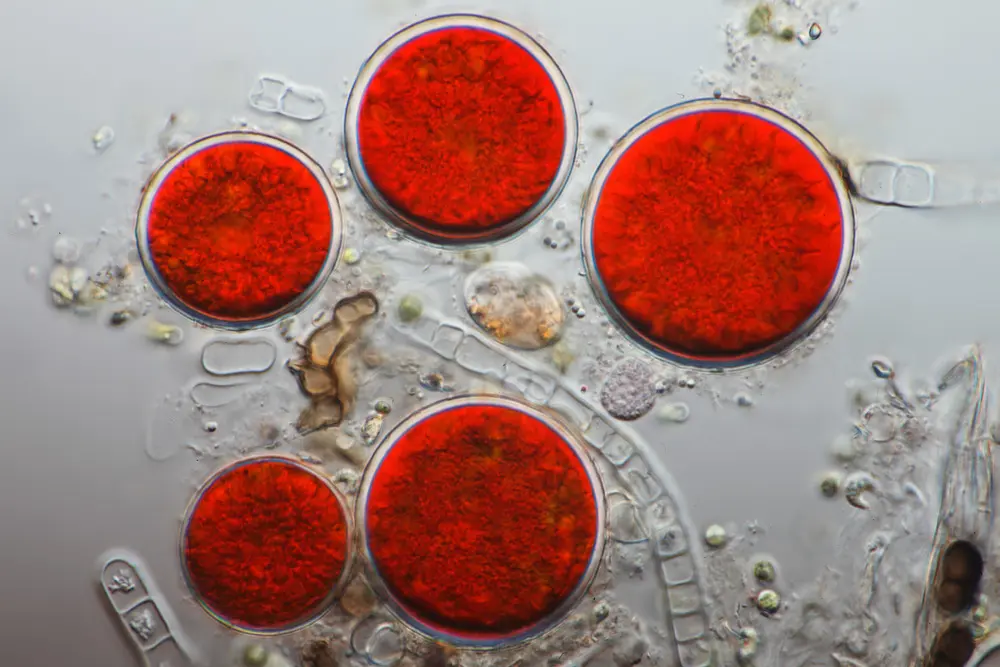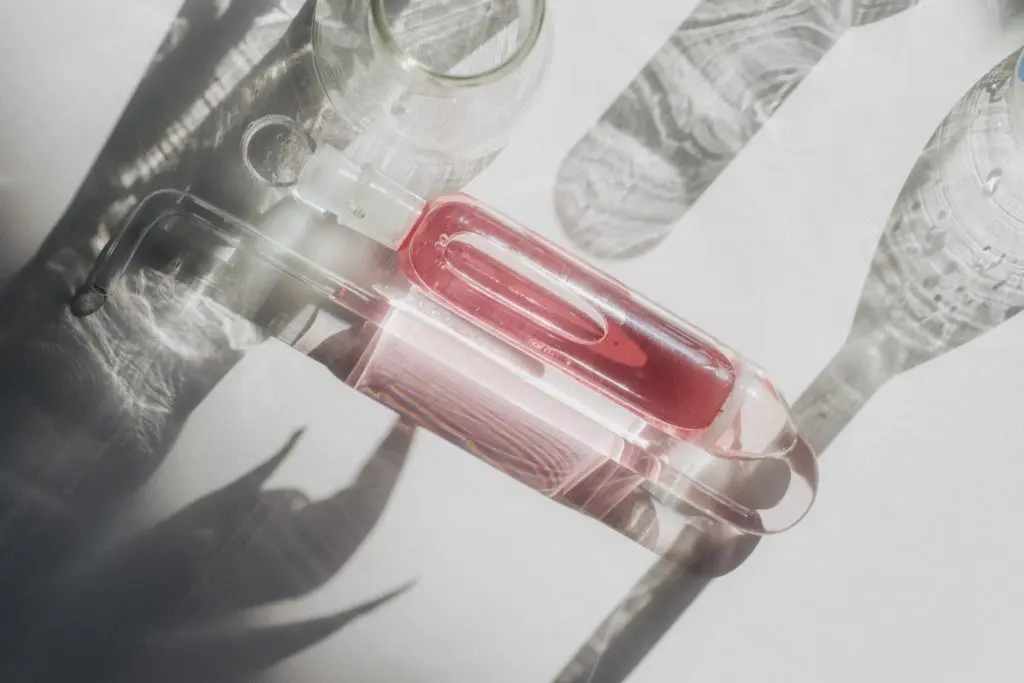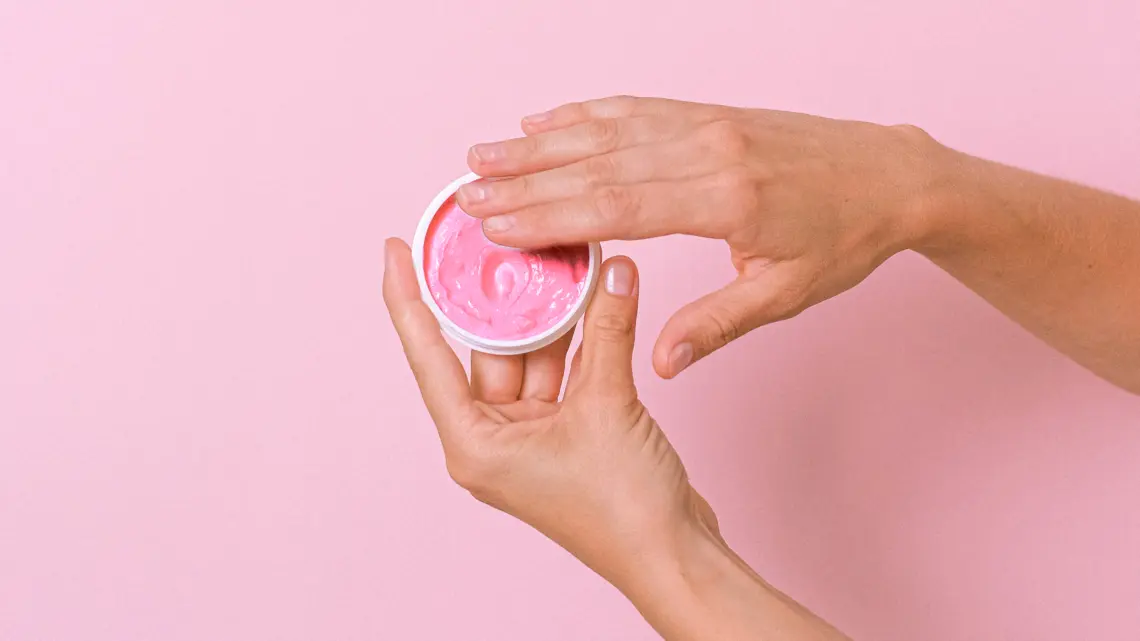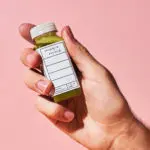Astaxanthin from the microalgae Haematococcus pluvialis not only has an impressive color but also has a lot to offer when it comes to its use in cosmetics, dietary supplements and new pharmacological applications. In its role as the most powerful antioxidant, it protects the skin, and is also already in use in several industries. In doing so, it has proven its worth, and yet new benefits and possibilities continue to be identified.
The microalgae Haematococcus pluvialis offers an efficient and natural way to replace synthetic Astaxanthin as well as safely develop sustainable products. But what exactly is behind Astaxanthin? What can it do and, most importantly, how can it be used in natural cosmetics?

Haematococcus pluvialis – The microalgae behind Astaxanthin
The microalga Haematococcus pluvialis is also called “blood rain alga”, because its reddish appearance can lead to spectacular phenomena in the wild. Ponds, water holes or pools in which they are found turn blood red.
This amazing spectacle is made possible by the carotenoid Astaxanthin, which occurs as a red pigment. This can even be observed in snow-covered mountains, where “blood snow” can occur in some places. The causative agents are not Haematococcus pluvialis, but nevertheless the Astaxanthin from other microalgae is the reason.

Astaxanthin – The Super-Carotenoid
The keto-carotenoid Astaxanthin was first isolated from lobster in 1938 in studies by Kuhn and Sorensen. This is where the name Astaxanthin comes from, as “astakós” means “lobster” in Greek. However, Astaxanthin is not only found in lobster, but in many other marine animals such as krill and salmon. As a result, it travels further up the food chain, where it then leads to phenomena such as the pink color of flamingos, among others.
Where does Astaxanthin come from?
Astaxanthin produced in petrochemical processes makes up the majority of the Astaxanthin that is currently in use. However, there are concerns about the safety of this synthetic Astaxanthin as far as human consumption is concerned. That is why natural Astaxanthin from the microalgae Haematococcus pluvialis offers a sustainable and safe alternative. Also in clinical trials, in humans at higher doses, no negative reactions were shown.
What is Astaxanthin used for?
In the beginning, it was only used in aquaculture to support the pigmentation of farmed salmonids (i.e. salmon, for example) so that the fish flesh would have a distinct orange-red color. Gradually, however, more and more benefits of Astaxanthin became known, which led to the fact that today Astaxanthin is also successfully used in the industries of food, cosmetics, dietary supplements and pharmaceuticals.
What distinguishes it from similar substances?
One of the most remarkable properties of Astaxanthin is its action as the most powerful natural antioxidant. However, it is not alone in this; there are many compounds with antioxidant effects. The difference, however, is in the degree of effectiveness. Comparative studies have shown that Astaxanthin has a greater antioxidant effect in the fibroblast of the skin than other carotenoids (for example, Canthaxanthin and -carotene).
In addition, Astaxanthin not only has an antioxidant effect, but also a unique overall molecular and biochemical profile, which as a whole benefits the human skin and body.
What does it do in the human organism?
Astaxanthin is considered to be the most powerful natural antioxidant, providing protection against free radicals and helping to protect cells. It also has anti-inflammatory properties, alleviating inflammation caused by oxidative stress in the body. Due to the biochemical structure of Astaxanthin, it can also have immune-boosting effects.
In addition, due to this said structure, it can also absorb UV rays to a certain extent. Thus, it can protect the skin from the sun by applying it in the form of creams. Another interesting property of Astaxanthin is that it promotes the endogenous mechanisms of DNA repair in our body.
How does Astaxanthin work?
Chemically, Astaxanthin has a similar structure to other carotenoids. The polar ionone rings at both ends are able to scavenge free radicals and other reactive oxygen species. This gives rise to the strong antioxidant properties.
The conjugated, polyunsaturated double bonds of carbon are responsible for the bright red-orange coloration, but also have the benefit of absorbing light. This in turn means that Astaxanthin can prevent cell damage caused by UV exposure.
In studies, Astaxanthin increased the cytotoxic (the property to damage or destroy living cells) activity of “natural killer cells”. It suggests that Astaxanthin can regulate the “natural killer cells”. These play a key role in the surveillance of the immune system and are essential to detect and destroy tumors and virus-infected cells.

Natural cosmetics – Application area for Astaxanthin
In what cosmetic products can Astaxanthin be used?
Astaxanthin in oleoresin (an oily type of resin) is ideal for the formulation of creams and serums due to its liquid form. Not only can it be used in commercial products due to its versatile beneficial properties, but it is also suitable for the development of dermatological skin care products with medical benefits.
In what form can Astaxanthin be produced?
Astaxanthin, from the microalgae Haematococcus pluvialis, is available as oleoresin, as already mentioned. It is extracted from the powder of the microalgae by means of supercritical fluid extraction. This not only has the advantage of using environmentally friendly solvents that are safe for consumption, but also preserves the Astaxanthin at the same time. Since low temperatures under moderate pressure can be used.
Apart from oleoresin, there is also Haematococcus pluvialis powder, which usually contains somewhat lower percentages of Astaxanthin. This is widely used in dietary supplements, for example.
What effect does it have on the skin?
Astaxanthin has shown in studies that it suppresses the synthesis of substances that damage the dermal extracellular matrix. This matrix contains collagen, elastin and glycosaminoglycans, all of which are responsible for skin tone and regulation. In concrete terms, this means that Astaxanthin helps to inhibit the substances that cause skin aging by making the skin more elastic. It also strengthens the skin barrier, which in turn reduces wrinkles.
By acting as the most powerful natural antioxidant, Astaxanthin efficiently protects the skin from free radicals generated by exogenous (e.g. UV radiation and polluted air) or endogenous (e.g. smoking) agents and substances. As a result, it protects cells from oxidative stress, which inhibits inflammation, reduces cellular damage, and can contribute to a healthy skin appearance.
In studies, Astaxanthin has also been shown to play a good supporting role in the wound healing process, making it an interesting candidate for dermatological treatment agents. In wound healing, the proper function of the dermal extracellular matrix is essential. As mentioned above, Astaxanthin suppresses the synthesis of substances that damage the skin, thus accelerating the healing process by allowing the skin to work optimally.
What are the benefits of Astaxanthin from Haematococcus pluvialis in cosmetics compared to other ingredients?
Probably the biggest stand-alone difference from other natural ingredients is that Astaxanthin is the most powerful natural antioxidant nature has to offer. This makes it naturally particularly efficient in protecting against free radicals and oxidative stress.
In addition, it has a versatile profile in terms of effects and biochemical composition, providing more than just an isolated benefit. It is the unique blend of beneficial effects combined with its role as the most potent natural antioxidant that makes Astaxanthin so unique.
Of course, how Astaxanthin is produced also plays a role. Extraction from the microalgae Haematococcus pluvialis makes it possible to produce a natural ingredient, which does not need to be produced synthetically and is therefore also sustainable.

Astaxanthin – Effective and sustainable at the same time
Astaxanthin from the microalgae Haematococcus pluvialis is an innovative building block for natural cosmetics. It offers the possibility of no compromise although it is not synthetically produced. Nevertheless, it offers strong and consistent performance as the most powerful natural antioxidant.
For more information on algae in the cosmetics industry, you are also welcome to take a look at the blogs “Algae Anti-Aging – Algae as a sustainable helper for young skin“, “Algae Sunscreen – Natural Protection From The Sun” and “Algae Skin Care – Algae in Skin Moisturizing Products“.
We at Alganex are of course happy to advise and supply any partners in the cosmetic industry. We want to help companies use conventional and also organic Astaxanthin efficiently, and promote microalgae to move together towards sustainable resources.
Sources
Sergio Davinelli, Michael E. Nielsen and Giovanni Scapagnini, “Astaxanthin in Skin Health, Repair, and Disease: A Comprehensive Review”
https://www.ncbi.nlm.nih.gov/pmc/articles/PMC5946307/
Kumi Tominaga, Nobuko Hongo, Mariko Karato and Eiji Yamashita ,“Cosmetic benefits of Astaxanthin on humans subjects”
https://pubmed.ncbi.nlm.nih.gov/22428137/
Qin Xiang Ng, MBBS, MRCP, Michelle Lee Zhi Qing De Deyn, MBBCh BAO, PGDip (Clin Derm), Wayren Loke, MBBS, Nadine Xinhui Foo, MBBS,Hwei Wuen Chan, MBBS, MMed (Ophth), FRCOphth, and Wee Song Yeo, MBBS, FRCPE, FRCPCH, PhD, FASN ,“Effects of Astaxanthin Supplementation on Skin Health: A Systematic Review of Clinical Studies”







Comments by Pit Wagner